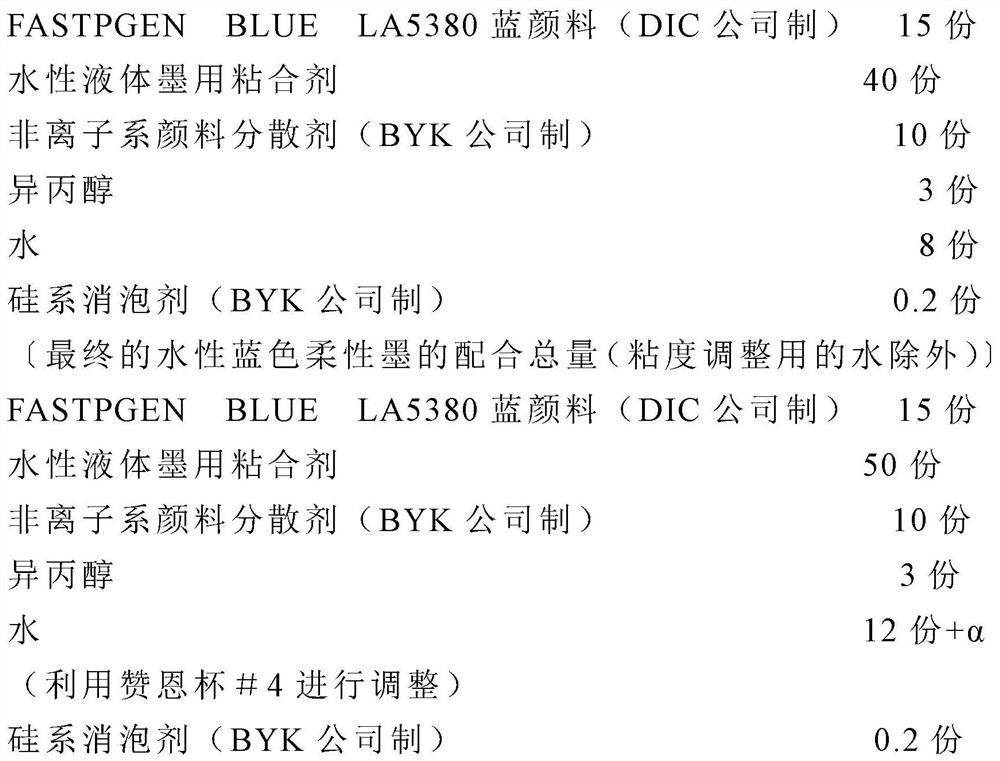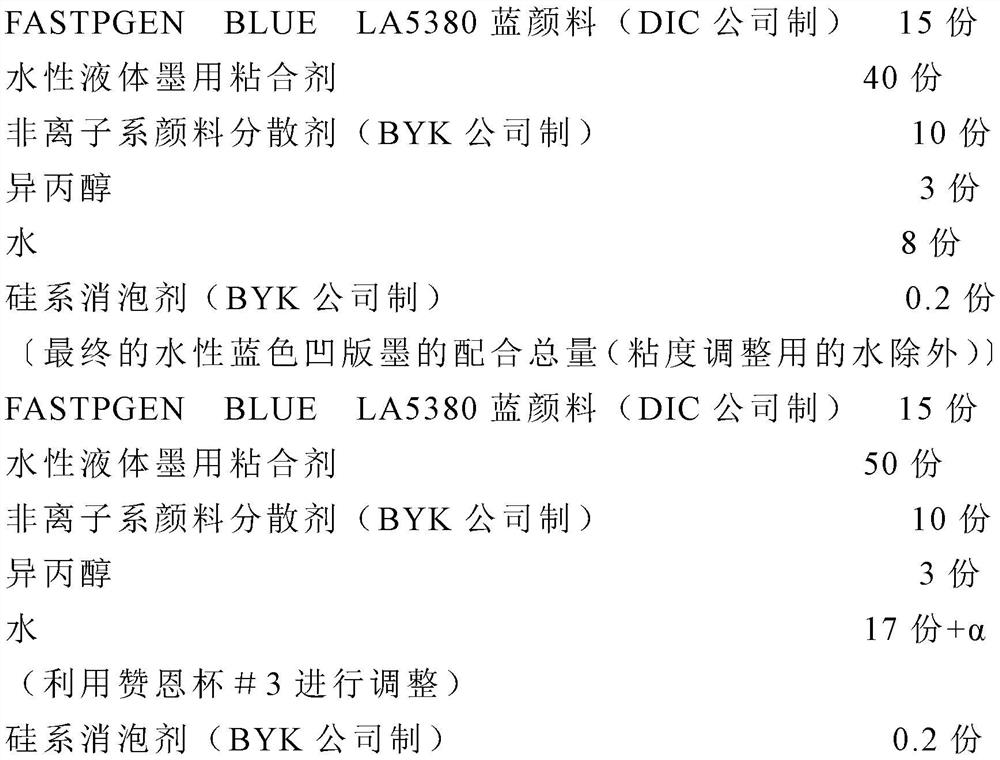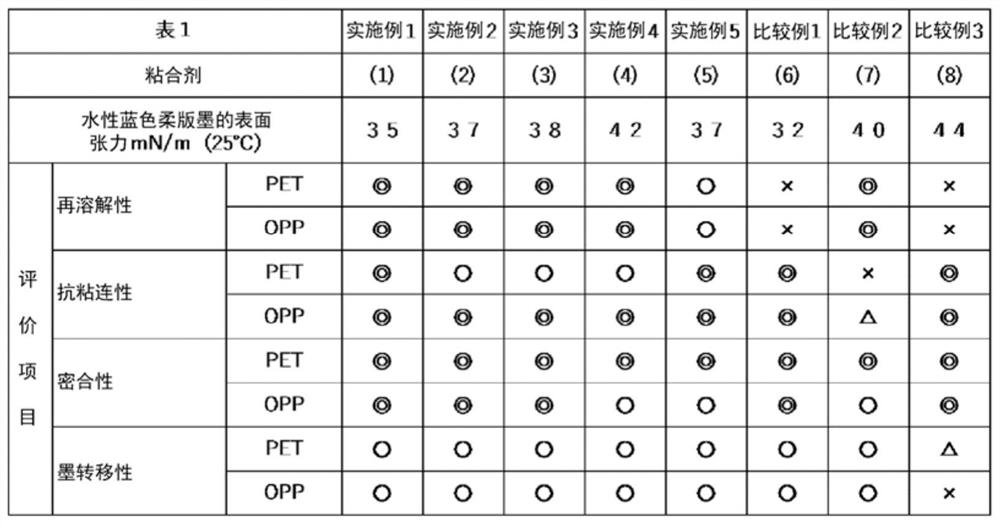Binder for aqueous liquid ink, aqueous liquid ink and printed matter
A water-based liquid and adhesive technology, applied in the direction of ink, application, household utensils, etc., can solve the problems of reducing resolvability, not being able to print in a long run, and not spreading faster, and achieve excellent resolvability.
- Summary
- Abstract
- Description
- Claims
- Application Information
AI Technical Summary
Problems solved by technology
Method used
Image
Examples
Synthetic example 1
[0086] (Synthesis Example 1: Preparation of Binder for Aqueous Liquid Ink (1))
[0087] 191 parts by mass of polyoxytetramethylene glycol (molecular weight: 2000), 141 parts by mass of isophorone diisocyanate, 2,2- 26 parts by mass of dimethylolpropionic acid react in a mixed solvent of 28 parts by mass of 1,4-cyclohexanedimethanol and 200 parts by mass of methyl ethyl ketone to obtain a prepolymerized carbamate having an isocyanate group at the molecular end. organic solvent solutions.
[0088] Next, by adding 20 parts by mass of a 50% potassium hydroxide aqueous solution, part or all of the carboxyl groups contained in the above-mentioned urethane prepolymer were neutralized, and 700 parts by mass of water and 9.0 parts by mass of an 80% aqueous hydrazine solution were added to fully Stirring was carried out to obtain an aqueous dispersion of polyurethane resin, followed by aging-desolventization to obtain a binder for aqueous liquid ink (1) with 40% by mass of non-volatile...
Synthetic example 2
[0091] (Synthesis Example 2: Preparation of Binder for Aqueous Liquid Ink (2))
[0092] 256 parts by mass of polyoxytetramethylene glycol (molecular weight: 2000), 102 parts by mass of isophorone diisocyanate, 2,2-bis 23 parts by mass of methylolpropionic acid were reacted in a mixed solvent of 6.5 parts by mass of neopentyl glycol and 200 parts by mass of methyl ethyl ketone to obtain an organic solvent solution of a urethane prepolymer having an isocyanate group at a molecular end.
[0093] Next, by adding 18 parts by mass of a 50% potassium hydroxide aqueous solution, part or all of the carboxyl groups contained in the above-mentioned urethane prepolymer were neutralized, and 700 parts by mass of water and 6.5 parts by mass of an 80% aqueous solution of hydrazine were added to fully Stirring was carried out to obtain an aqueous dispersion of polyurethane resin, followed by aging-desolventization to obtain an aqueous liquid ink binder (2) with 40% by mass of non-volatile com...
Synthetic example 3
[0095] (Synthesis Example 3: Preparation of Binder for Aqueous Liquid Ink (3))
[0096] 263 parts by mass of polyoxytetramethylene glycol (molecular weight: 2000), 98 parts by mass of isophorone diisocyanate, 2,2-bis 22 parts by mass of methylolpropionic acid react in a mixed solvent of 5.6 parts by mass of 1,4-cyclohexanedimethanol and 200 parts by mass of methyl ethyl ketone to obtain a urethane prepolymer having an isocyanate group at the molecular end of organic solvent solutions.
[0097] Next, by adding 17 parts by mass of a 50% potassium hydroxide aqueous solution, part or all of the carboxyl groups possessed by the above-mentioned urethane prepolymer was neutralized, and 700 parts by mass of water and 6.2 parts by mass of an 80% aqueous hydrazine solution were added and fully stirred, Thus, an aqueous dispersion of the polyurethane resin was obtained, followed by aging-desolventization, to obtain a binder for aqueous liquid ink (3) with 40% by mass of non-volatile mat...
PUM
| Property | Measurement | Unit |
|---|---|---|
| surface tension | aaaaa | aaaaa |
Abstract
Description
Claims
Application Information
 Login to View More
Login to View More - R&D
- Intellectual Property
- Life Sciences
- Materials
- Tech Scout
- Unparalleled Data Quality
- Higher Quality Content
- 60% Fewer Hallucinations
Browse by: Latest US Patents, China's latest patents, Technical Efficacy Thesaurus, Application Domain, Technology Topic, Popular Technical Reports.
© 2025 PatSnap. All rights reserved.Legal|Privacy policy|Modern Slavery Act Transparency Statement|Sitemap|About US| Contact US: help@patsnap.com



